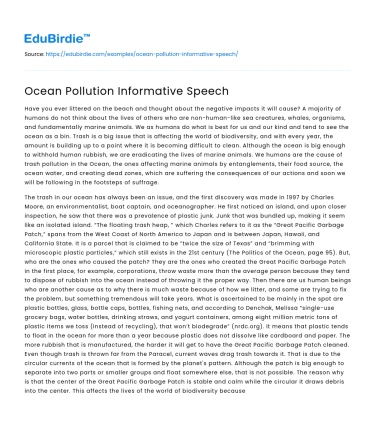Have you ever littered on the beach and thought about the negative impacts it will cause? A majority of humans do not think about the lives of others who are non-human-like sea creatures, whales, organisms, and fundamentally marine animals. We as humans do what is best for us and our kind and tend to see the ocean as a bin. Trash is a big issue that is affecting the world of biodiversity, and with every year, the amount is building up to a point where it is becoming difficult to clean. Although the ocean is big enough to withhold human rubbish, we are eradicating the lives of marine animals. We humans are the cause of trash pollution in the Ocean, the ones affecting marine animals by entanglements, their food source, the ocean water, and creating dead zones, which are suffering the consequences of our actions and soon we will be following in the footsteps of suffrage.
The trash in our ocean has always been an issue, and the first discovery was made in 1997 by Charles Moore, an environmentalist, boat captain, and oceanographer. He first noticed an island, and upon closer inspection, he saw that there was a prevalence of plastic junk. Junk that was bundled up, making it seem like an isolated island. “The floating trash heap, ” which Charles refers to it as the “Great Pacific Garbage Patch,” spans from the West Coast of North America to Japan and is between Japan, Hawaii, and California State. It is a parcel that is claimed to be ”twice the size of Texas” and “brimming with microscopic plastic particles,” which still exists in the 21st century (The Politics of the Ocean, page 95). But, who are the ones who caused the patch? They are the ones who created the Great Pacific Garbage Patch in the first place, for example, corporations, throw waste more than the average person because they tend to dispose of rubbish into the ocean instead of throwing it the proper way. Then there are us human beings who are another cause as to why there is much waste because of how we litter, and some are trying to fix the problem, but something tremendous will take years. What is ascertained to be mainly in the spot are plastic bottles, glass, bottle caps, bottles, fishing nets, and according to Denchak, Melissa “single-use grocery bags, water bottles, drinking straws, and yogurt containers, among eight million metric tons of plastic items we toss (instead of recycling), that won’t biodegrade” (nrdc.org). It means that plastic tends to float in the ocean for more than a year because plastic does not dissolve like cardboard and paper. The more rubbish that is manufactured, the harder it will get to have the Great Pacific Garbage Patch cleaned. Even though trash is thrown far from the Paracel, current waves drag trash towards it. That is due to the circular currents of the ocean that is formed by the planet's pattern. Although the patch is big enough to separate into two parts or smaller groups and float somewhere else, that is not possible. The reason why is that the center of the Great Pacific Garbage Patch is stable and calm while the circular it draws debris into the center. This affects the lives of the world of biodiversity because it is putting them in danger.
Save your time!
We can take care of your essay
- Proper editing and formatting
- Free revision, title page, and bibliography
- Flexible prices and money-back guarantee






 Stuck on your essay?
Stuck on your essay?

